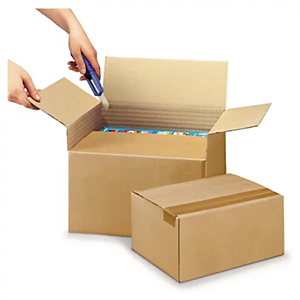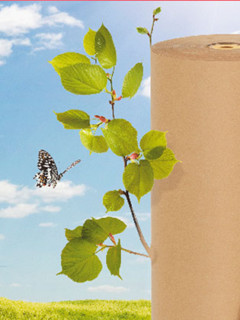The low dead weight and dimensional stability make packaging chips the ideal filling material for cavities in cartons, and at the same time they protect against impacts. However, they usually have a bad reputation because they are considered harmful to the environment. But with the flo-pak® packaging material, the opposite is more the case. One variant of the packaging chips is even edible.
flo-pak® – From drinking straw to cavity filling
The history of flo-pak® filling material begins as early as the 1950s: The Safe-T Pacific company in the USA, which actually produced paper drinking straws, sold the superfluous cut ends produced during production as padding material – a second mainstay that soon proved to be extremely viable. Thanks to increasing demand, Arthur Graham founded the Free-Flow Packaging Corporation in December 1967 to concentrate fully on the production of this promising loose padding material. A year later, a new extrusion process replaced the paper stalk with lightweight expanded polystyrene, reducing the weight of the packaging material by 80%. It was also at this time that the now characteristic shape of the “8” was created, which provided more stability and cushioning protection thanks to its interlocking with other eight-shaped parts in the carton during transport. Following the rapid development, “flo-pak®” (a similarity to the company’s name “Flow” was quite intentional) was registered as a trademark on 6 September 1970 and today it is impossible to imagine any packaging range without it. Since 1989, only 100% recycled materials have been used for production. Therefore, these small packaging chips are an optimal combination of environmental protection and cushioning strength. In 1992, the company then developed the 100% biodegradable corn starch filler chips. In 1995, Flo Pak was even named the “lightest man-made product” by the Guniess Book of Records. In 2009, FP International then developed FLO-PAK GREEN, the world’s first degradable EPS filler chip, made from 100% recycled material and degraded into humus.
In 1996, due to its increased international success, the company changed its name to Free-Flow Packaging International, Inc. and adopted FP International as its trade name. In 2018, FP was acquired by Pregis LLC, a leading provider of innovative protective packaging materials, finishing systems and surface protection. FLO-PAK, now part of Pregis, has received national recognition for its unique polystyrene recycling programme, including awards from the U.S. Environmental Protection Agency and the National Recycling Coalition, as well as numerous state and local environmental organisations.
Cornstarch packaging material!?
flo-pak® Standard
The particularly lightweight filling material consists of 99.6% air, the rest is 100% recycled polystyrene. It is antistatic, dust-free and odourless…. The “open 8” ensures optimal cavity filling. It can often be reused and disposed of in plastic waste as it is 100% recyclable. Disposal via residual waste is also possible, but not desirable 🙂
flo-pak® Green
The “filled 8” makes flo-pak® Green even more stable and especially suitable for cushioning heavy and differently shaped products. Enzymes are added to these packaging chips during production. Together with micro-organisms, the enzymes are able to completely degrade the material without the release of harmful substances, within 9 – 60 months, should the chips accidentally end up in the environment. The packaging chips can be reused up to 10 times or recycled industrially with other plastic chips.
flo-pak® Natural
The flo-pak® Natural is even made entirely from natural raw materials: air, water and corn starch. This makes the filler chips reusable but also completely biodegradable, even in seconds, if you spray it with water and bury it. Corn – that sounds edible. And yes, you could eat this packaging material. Because as the toxicological data say: harmless to humans and animals if eaten accidentally.















